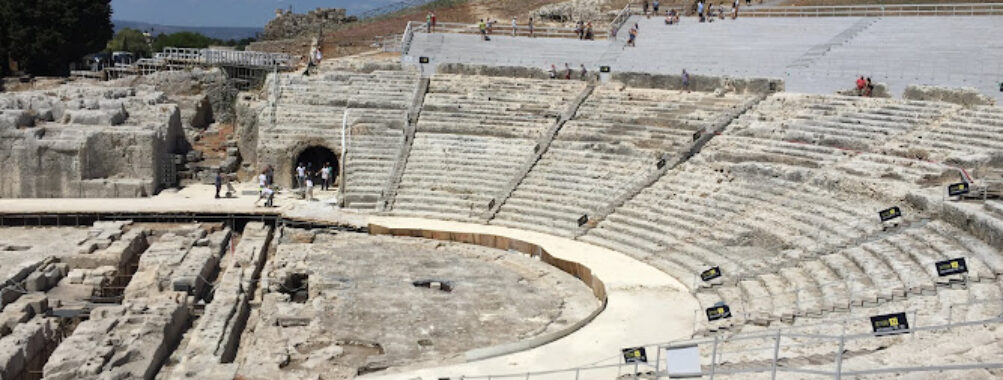
Neapolis Archaeological Park
Table of Contents
Description
The Neapolis Archaeological Park in Syracuse is one of those places that somehow manages to feel both grand and intimate at the same time. It’s sprawling – a mix of sun-baked stone, patches of green, and echoes of voices that haven’t spoken in millennia – yet you can wander it at your own pace and still feel like you’re discovering something personal. Visitors come here for the ancient Greek theater, sure, but the park is more than just one showpiece. It’s a patchwork of history layered into the landscape: Roman amphitheaters, mysterious caves, and even a church carved into rock. And while some parts have been weathered by time (and the occasional tourist crowd), the sheer scale and variety make it worth the effort.
It’s not a perfectly polished tourist attraction – and honestly, that’s part of the charm. There are uneven paths, sun glare that makes you squint, and moments when you’ll wish you brought more water. But then you’ll turn a corner and see the Greek theater stretching out in front of you, or hear your footsteps echo inside the Ear of Dionysius cave, and you’ll forget about everything else. The park is accessible for wheelchairs and strollers, with ramps and designated parking, though some areas are easier to navigate than others. And yes, there’s paid parking on-site, which is convenient if you’re not up for hunting a spot in the streets nearby.
I’ve been to a lot of archaeological sites, and what sets Neapolis apart is how alive it feels. You can almost picture the crowds that once filled the seats, the actors shouting their lines to the sky, the workers carving stone in the heat. It’s a place where history isn’t just behind glass – it’s under your feet, in the air, and in the way the sunlight hits the ruins. Sure, there are moments when you’ll be sharing the view with a busload of other visitors, but if you give yourself time, you can find quiet corners where the centuries seem to fold in on themselves.
Key Features
- Ancient Greek Theater – still used for performances during the summer season
- Roman Amphitheater – an impressive reminder of Syracuse’s Roman era
- Ear of Dionysius – a limestone cave with remarkable acoustics and legends attached
- Altar of Hieron II – one of the largest known sacrificial altars from antiquity
- Rock-cut church and catacombs – blending religious history with ancient engineering
- Expansive gardens and pathways – offering shade and scenic walking routes
- Wheelchair-accessible entrance and parking
- Paid on-site parking for convenience
Best Time to Visit
If you can, aim for spring or late autumn. The weather is mild, the light is beautiful, and you won’t be battling the thickest of the tourist crowds. Summer can be brutally hot – I once made the mistake of visiting in July, and I swear the stone radiated heat like an oven. On the flip side, summer is also when the Greek theater hosts live performances, which is magical if you can handle the warmth. Early morning or late afternoon visits are ideal year-round, not just for the cooler temperatures but also for the way the low sun throws long shadows across the ruins. Winter is quieter, but you might get the occasional rain shower, so bring a light jacket just in case.
How to Get There
The park sits just outside the main modern center of Syracuse, and getting there is straightforward. If you’re staying in Ortigia, you can take a short bus ride or even walk if you’re feeling energetic – though keep in mind it’s a bit of an uphill trek. Taxis and rideshares are easy to arrange, and driving is an option if you’re comfortable with Sicilian traffic. The on-site paid parking lot is a lifesaver if you’re visiting during peak hours. Public transportation is reliable enough, but schedules can be a little loose, so give yourself some buffer time. If you’re coming from Catania or another nearby city, regional trains and buses connect you to Syracuse, and from the station, it’s a quick hop to the park.
Tips for Visiting
First things first: wear comfortable shoes. The park is big, and you’ll be covering a lot of ground on uneven surfaces. Bring water – more than you think you’ll need – especially in the warmer months. A hat and sunscreen aren’t optional unless you enjoy leaving with a sunburn souvenir. If you’re into photography, try to time your visit for early morning or golden hour; the light is softer, and you’ll avoid the harsh midday glare.
Buy your tickets ahead of time if possible, especially during the summer tourist rush. Guided tours can be worth it here – not just for the history, but for the little stories and details you might otherwise miss. If you’re short on time, prioritize the Greek theater, the Ear of Dionysius, and the Roman amphitheater. And don’t rush – some of the best moments are just sitting on a stone bench, imagining the lives that passed through here centuries ago.
One last thing: be patient. This isn’t a place you “do” in 30 minutes. Give it a couple of hours at least, and let yourself wander. The Neapolis Archaeological Park rewards curiosity, and if you slow down, it has a way of making you feel like you’re not just looking at history – you’re part of it.
Location
Places to Stay Near Neapolis Archaeological Park
Find and Book a Tour
Explore More Travel Guides
No reviews found! Be the first to review!